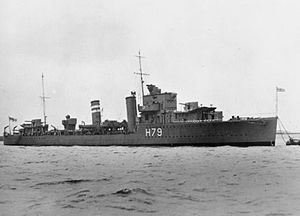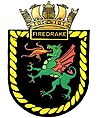HMS Firedrake (H79)
 Firedrake at anchor before 1942
| |
| History | |
|---|---|
| Name | HMS Firedrake |
| Namesake | firedrake |
| Ordered | 17 March 1933 |
| Builder | Parsons Marine Steam Turbine Company, Wallsend |
| Cost | £243,966 |
| Laid down | 5 July 1933 |
| Launched | 28 June 1934 |
| Commissioned | 30 May 1935 |
| Motto |
|
| Fate | Sunk by U-211, 16/17 December 1942 |
| Badge |  |
| General characteristics | |
| Class and type | F-class destroyer |
| Displacement |
|
| Length | 329 ft (100.3 m) o/a |
| Beam | 33 ft 3 in (10.13 m) |
| Draught | 12 ft 6 in (3.81 m) (deep) |
| Installed power |
|
| Propulsion | 2 × shafts; 2 × Parsons geared steam turbines |
| Speed | 35.5 knots (65.7 km/h; 40.9 mph) |
| Range | 6,350 nmi (11,760 km; 7,310 mi) at 15 knots (28 km/h; 17 mph) |
| Complement | 145 |
| Sensors and processing systems | ASDIC |
| Armament |
|
HMS Firedrake was an
Several weeks after the start of the
Description
The F-class ships were repeats of the preceding
The ships mounted four
Wartime modifications
By October 1940, Firedrake had her rear torpedo tube mount replaced by a
Construction and career
Firedrake, the sixth ship of her name in the Royal Navy,
Upon its completion on 30 September, the ship returned to the Mediterranean and began to enforce the arms embargo imposed on both sides in the Spanish Civil War by the
World War II
In September 1939 Firedrake was assigned to the
In the Norwegian Campaign, she supported the
Firedrake was briefly assigned to the
On 1 January 1941, Firedrake was one of the ships that intercepted a
During
After escorting Convoy NA 2 to the UK in January 1942, the ship was assigned to
In media
Stock footage of HMS Firedrake (H79) was featured in the movie The Spy in Black (1939)
References
- ^ "HMS Firedrake Association website". Retrieved 10 January 2016.
- ^ a b c Lenton, p. 156
- ^ March, p. 296
- ^ Whitley, p. 103
- ^ English, p. 141
- ^ Friedman, pp. 241, 243
- ^ Colledge, p. 126
- ^ English, pp. 75–76, 79–80
- ^ a b c d English, p. 80
- ^ Smith, pp. 30, 35
- ^ Haarr, pp. 266, 269, 300, 312
- ^ Rohwer, p. 37–38
- ^ Admiralty Historical Section 2002, Vol. I, p. 70; Rohwer, p. 45
- ^ Rohwer, pp. 47, 49–50; Smith, pp. 70–75
- ^ Osborne, p. 26
- ^ Admiralty Historical Section 2002, Vol. II, pp. 48–53; English, p. 80
- ^ English, p. 80; Smith, p. 108
- ^ English, p. 80; Rohwer, pp. 140, 165, 212, 219
- ^ The rescue of the survivors is described on pages 76/77 in the autobiography of John Treasure Jones, who was the Captain of HMS Sunflower
Bibliography
- Divine, A. D. (1942). Destroyer's War: A Million Miles by the Eighth Flotilla. John Murray. OCLC 875295237.
- Admiralty Historical Section (2002). The Royal Navy and the Mediterranean: September 1939–October 1940. Whitehall histories, Naval Staff histories. Vol. I. London: Whitehall History in association with Frank Cass. ISBN 0-7146-5179-6.
- Admiralty Historical Section (2002). The Royal Navy and the Mediterranean: November 1940–December 1941. Whitehall histories, Naval Staff histories. Vol. II. London: Whitehall History in association with Frank Cass. ISBN 0-7146-5205-9.
- ISBN 978-1-86176-281-8.
- English, John (1993). Amazon to Ivanhoe: British Standard Destroyers of the 1930s. Kendal, England: World Ship Society. ISBN 0-905617-64-9.
- Friedman, Norman (2009). British Destroyers From Earliest Days to the Second World War. Annapolis, Maryland: Naval Institute Press. ISBN 978-1-59114-081-8.
- Haarr, Geirr H. (2010). The Battle for Norway: April–June 1940. Barnsley, UK: Seaforth Publishing. ISBN 978-1-84832-057-4.
- Lenton, H. T. (1998). British & Empire Warships of the Second World War. Annapolis, Maryland: Naval Institute Press. ISBN 1-55750-048-7.
- March, Edgar J. (1966). British Destroyers: A History of Development, 1892–1953; Drawn by Admiralty Permission From Official Records & Returns, Ships' Covers & Building Plans. London: Seeley Service. OCLC 164893555.
- Osborne, Richard, Dr. (February 2011). "Ration: Royal Navy Operations Against the Vichy French Merchant Fleet 1940–1942". Warships (165). Part One. London: World Ship Society: 21–34. ISSN 0966-6958.)
{{cite journal}}: CS1 maint: multiple names: authors list (link - Rohwer, Jürgen (2005). Chronology of the War at Sea 1939–1945: The Naval History of World War Two (Third Revised ed.). Annapolis, Maryland: Naval Institute Press. ISBN 1-59114-119-2.
- Smith, Peter C. (2004). Destroyer Leader: The Story of HMS Faulknor 1935–46 (3rd revised and expanded ed.). Barnsley, South Yorkshire, UK: Pen & Sword Maritime. ISBN 1-84415-121-2.
- Whitley, M. J. (1988). Destroyers of World War Two: An International Encyclopedia. Annapolis, Maryland: Naval Institute Press. ISBN 0-87021-326-1.
- Treasure Jones, John (2008). Tramp to Queen. The History Press. ISBN 978-0-7524-4625-7.
